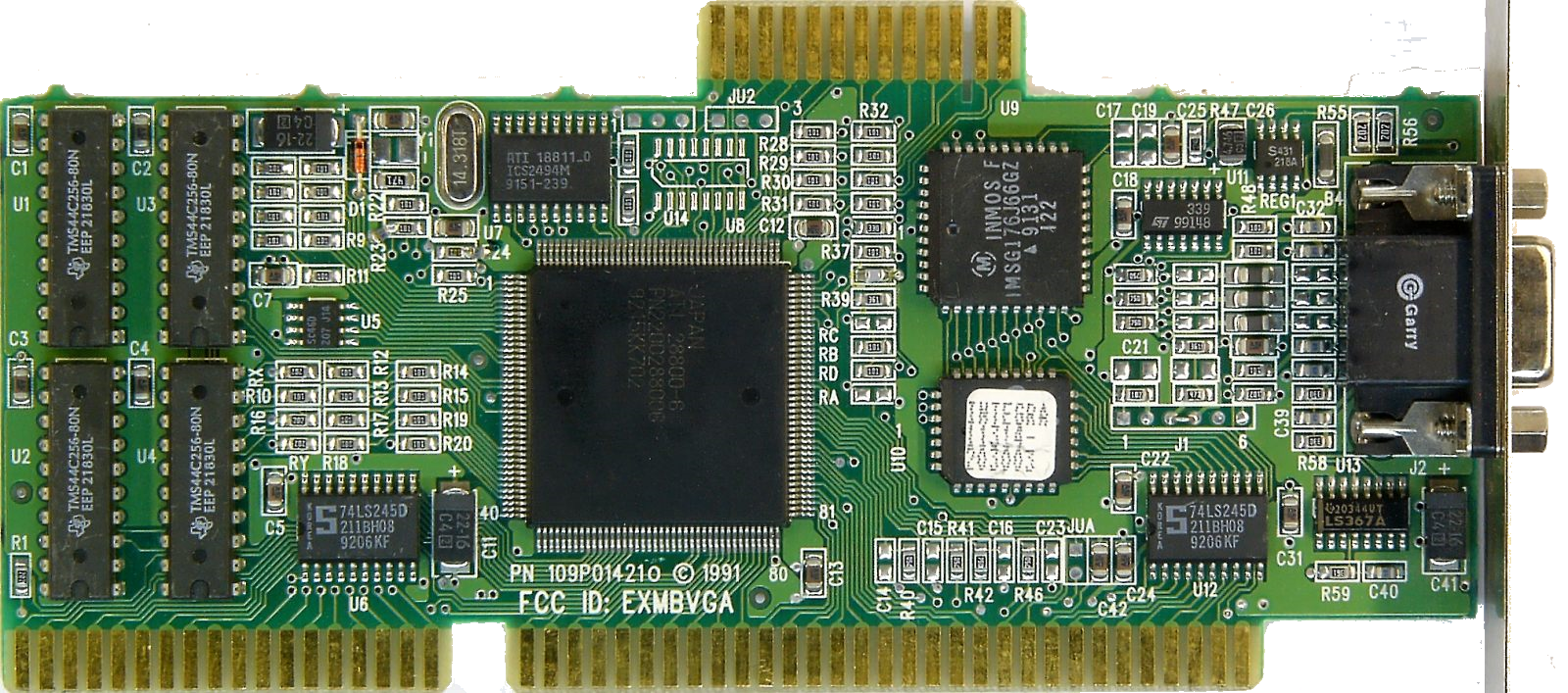ATI VGA Integra
Also launched in 1990, the Integra was a cost-reduced version of the VGA Wonder+ and shared the same new 28800 chipset. It had a much smaller PCB with surface-mounted BIOS and RAMDAC chips, and lacked the bus mouse connector. This card supported SVGA 72 Hz refresh rates, and came with 512 KB DRAM as standard.
 |
Released | 1990 |
| Bus | ISA 16-bit | |
| Chipset | ATi 28800-2 | |
| Standards | Hercules, CGA, EGA, VGA, and SVGA | |
| Memory | 512 KB | |
| Ports | 15-pin DSUB (RGB analogue) VESA Feature connector |
|
| Part # | 109P014210 | |
| FCC ID | EXMBVGA | |
| Price | At launch: $189, Feb 1992: $129 | |
| See Also | VGA Wonder+, VGA Edge series, VGA Basic-16 |
The VGA Integra shares its ROM BIOS firmware with the VGA Edge series, VGA Basic-16 and VGA Charger.
Board Revisions
No details are known on different revision of this card.
Competition
No details are known on the competition this card competed against.
In the Media
Click here for an advertisement in PDF format of the VGA Integra.
Based on ATI's own proprietary chip set and designs, the VGA Integra is as small as its price, just barely longer than its ISA bus 16-bit edge connector, and only about half as tall as the standard expansion card bracket, which carries the 15-pin video cable connector. Unlike some of the other cards included in this review, this adapter still makes room for a VGA pass-through connector at the top of the board - a feature required by many add-on high-resolution display adapters that do not provide their own VGA support.
You are not likely to need any other adapters, however, if you start with the VGA Integra. It provides 256-color support at 800-by-600 resolution and a 16-color 1,024-by-768 noninterlaced mode. Part of the reason for its low cost is the VGA Integra's ability to manage these high resolutions with just 512K of onboard memory.
Another reason for the lower price is that the card does not sport as sophisticated a design as some of its competitors. While it supports a 72-Hz vertical refresh rate for VGA and 16-color 800-by-600 modes, it can only manage 70 Hz when displaying 256 colors at 800-by-600 resolution. And for the 16-color 1,024-by-768 noninterlaced mode, it only offers a 60-Hz vertical refresh rate.
The VGA Integra also failed to keep pace with the fastest of the competition on most of the PC Magazine Labs' benchmark tests. While most of its times fell somewhere in the second half of the pack, the card came in last on all but two of the 256-color 800-by-600 Microsoft Windows tests. It did, however, excel at BitBlts in standard 16-color VGA mode, finishing in the top five for that test and indicating strong Windows graphics capabilities.
The low price does not come at the expense of support features, however. The documentation is exemplary, installation is a breeze, and ATI offers free technical support through phone, fax, and an electronic bulletin board system.
It budget constraints rank high on your list of decision criteria, or if you are simply buying a VGA system now but want the option of higher resolutions later without having to change cards, the VGA Integra is an excellent choice; other cards may be faster, but few offer such high resolutions at such an attractive price."
PC Magazine, September 1991
Setting it Up
No configuration is required for the VGA Integra, with its auto-switching capability. The card came with a utility to force the display mode if necessary.
Downloads
Operation Manual Get in touch if you can provide this missing item! |
Original Utility Disk Get in touch if you can provide this missing item! |
VGA BIOS ROM Get in touch if you can provide this missing item! |
DOS Drivers ATI VGA Wonder Series drivers for DOS. Includes utilities, a VESA driver, a mouse driver and software drivers for WordStar 3.31, 4.0 and 5.0, WordPerfect 4.1, 4.2, and 5.0, |
Windows 3.1 Drivers ATI VGA Wonder Series drivers for Windows 3.1. |
More Pictures
No additional pictures are available.